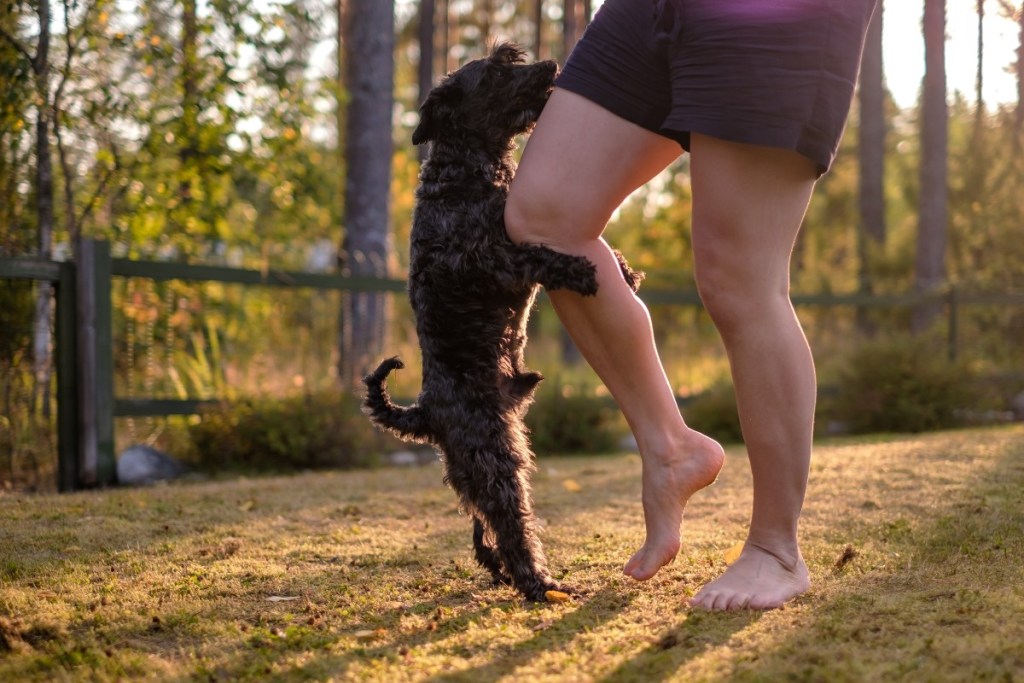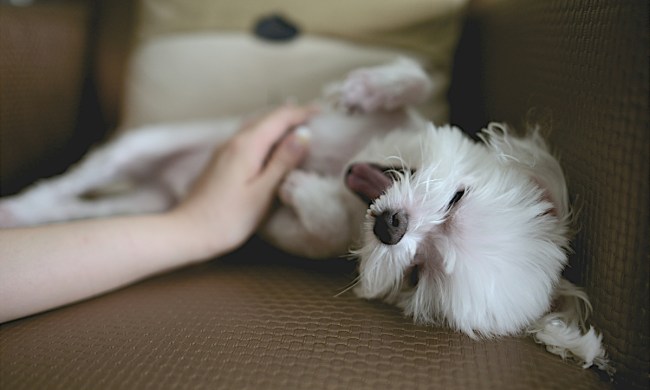Polite society has changed over the years. We used to not discuss politics at the dinner table. Now, it’s all we discuss at the dinner table. However, humping in public remains a faux pas.
Unfortunately, not all dogs got the memo. Some pups will mount other dogs or humans. Their habit isn’t limited to living creatures, either — pillows, blankets, and fence posts are all fair game in their minds.
Remember, dogs don’t always play by the same rules as humans. After all, it’s usually frowned upon when a human pees outside, but we praise our pups for it. However, humping is a habit worth stopping. It can not only be embarrassing but could also cause issues with other dogs. Let’s discuss what triggers this behavior and how to stop a dog from humping.

Why do dogs hump?
We often associate humping with sexual activity. Though that’s not always the case with dogs, it can be. Unfixed dogs are generally more prone to sexually-motivated mounting. Mounting is a way to achieve sexual pleasure, and some puppies may even hump their littermates. Intact male dogs may try to court females to mount and hump something else if prevented.
Even females will hump because it feels good.
How can you tell if your dog is humping for sexual pleasure? The mounting will usually come after some flirting, such as licking, pawing, and playfully bowing.
However, oftentimes humping has nothing to do with sex.
Why do fixed dogs hump?
If your dog is spayed or neutered and humping, you may tell them, “Dude, it’s not going to work.” However, chances are they’re mounting for other reasons, including:
- Dominance. Dogs may mount a pet or person to exert control over another animal in the house or even you.
- Stress or over-excitement. Sometimes, dogs hump as a way to relieve stress. Other times, they may be overstimulated and need a way to cope with their excitement.
- Play. Canines may not know what acceptable play looks like and think humping is a game.
- Medical issues. If your dog begins humping out of the blue, they might be sick or in pain. Urinary tract infections, incontinence, and allergies can trigger mounting, particularly if the pup is also excessively licking or biting the genital area.
How to stop a dog from humping
A humping dog can be a massive turn-off when you have guests, even if the behavior isn’t sexual. It can also cause issues during doggie playdates. It’s possible to curb this behavior, though. Try these tips.
See a veterinarian
A vet can help you rule out any medical conditions. If there is a medical issue, they can prescribe treatment so your dog feels better and stops humping to self-soothe.
Neuter or spay your dog
Intact dogs will be more sexually motivated to hump. Neutering your male dog will give him one less reason to want to mount your leg or another dog. Spaying a female dog can also reduce her urge to hump, particularly if she only does it while in heat.
Re-direct
Pups may show certain signs they are about to hump, such as licking another dog or pacing. Take note of these patterns. When you notice your dog going into its pre-mounting mode, try to stop the behavior before it starts by distracting the pup. Throw a ball, wave their favorite toy around, or call them over for a snuggle.
Set boundaries
We don’t like saying no to our dogs. Remember, our dogs crave our direction and want to please us. A firm “no” and gentle push off our legs when they hump may be just the message they need to stop.
Avoid triggers when possible
Some dogs only hump in certain situations, particularly if the behavior is stress-induced, and avoiding them can eliminate humping. For example, as fun as dog parks may seem, they could be a source of anxiety for your pet. Consider socializing them on a playdate with one other dog instead.
Work on training
You likely can’t avoid every single stressful or overstimulating situation for your pet. For example, you probably want to have visitors in your home. Training your dog to sit and stay and using those commands in stressful situations can help mitigate mounting. You may want to consider working with a trainer or behavioral specialist.
Dogs will be dogs
When your dog humps your gram’s leg, your face may turn 50 shades of red. You love your dog but talk about awkward! Though sometimes the behavior is sexual, particularly with intact dogs, that’s not always the case. Dominance, boredom, stress, and overstimulation are common reasons for mounting. Your dog also may have a medical issue, such as a urinary tract infection. You can stop a dog from humping by getting them spayed or neutered, though it’s not a fix-all (altered dogs sometimes hump, too). Re-directing, discouraging the behavior, and avoiding trigger situations can help. Be sure to see a vet to rule out medical issues. A behavioral specialist or trainer can help you work out the kinks and reduce doggie mounting.




